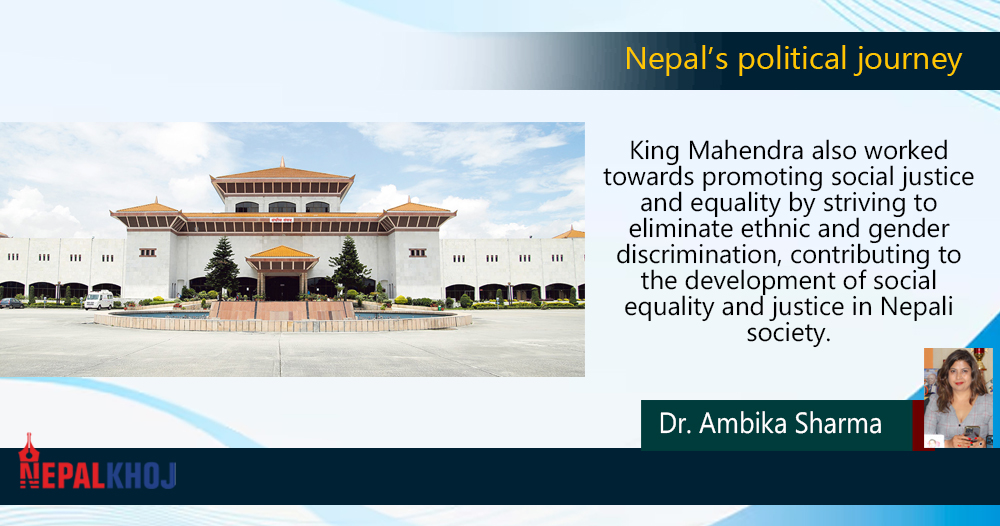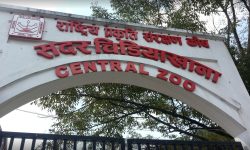Where Did We Fail in History? What Are We Doing in the Present? And Where Is the Future Heading ?

Nepal’s political journey has been a series of movements aimed at establishing democratic representation. The initial establishment of democracy occurred in the 1950s following the end of the Rana regime, starting with the 1951 revolution. This led to a democratic governance framework.
However, King Mahendra’s imposition of monarchy in 1960 curtailed this democracy by dissolving political parties and centralizing power, limiting citizens’ freedoms. Despite this, the monarchy played a significant role in Nepal’s political and social transformation, with Mahendra’s policies greatly impacting economic and social development.
During his reign, the establishment of the Nepal Rastra Bank and the Supreme Court occurred, enhancing the organization and effectiveness of Nepal’s economic and judicial systems. King Mahendra’s era also marked Nepal’s significant international recognition, particularly with its UN membership, which strengthened diplomatic ties and the country’s global standing. He initiated Nepal’s first Five-Year Plan in 1956, focusing on production growth, job creation, and improved living standards. The Mahendra Highway connected east-west road networks to north-south routes, facilitating trade and contributing significantly to economic development and national unity.
During his reign, significant changes occurred in Nepal’s social sector, particularly through the establishment of hospitals and health centers aimed at improving public health. He also introduced plans to enhance agriculture by increasing production, providing modern tools and technologies to farmers, and offering agricultural education and training. These initiatives greatly transformed Nepal’s agricultural landscape and improved the living standards of farmers. King Mahendra also worked towards promoting social justice and equality by striving to eliminate ethnic and gender discrimination, contributing to the development of social equality and justice in Nepali society.
The Panchayat system established by King Mahendra was abolished by the democratic movement, leading to the restoration of multiparty democracy under constitutional monarchy in 1990. King Birendra is remembered as a capable monarch striving to maintain national unity amidst political challenges. Tragically, he and his family were killed in a royal massacre on June 1, 2001, shocking Nepal and the world.
Despite these changes, Nepal’s journey toward stable democracy has faced challenges like corruption and political infighting, exacerbated by the Maoist insurgency in the 1990s. Following the royal family’s assassination, King Gyanendra assumed power but faced widespread protests, culminating in his resignation in 2006 and the abolition of the monarchy.
Nepal began a journey towards a federal democratic republic after formally adopting a new constitution in 2015. This transition has led to significant political inclusion and decentralization of power, but challenges like political instability and economic struggles remain unresolved. The establishment of democracy, especially post-monarchy, has transformed the political landscape, allowing diverse groups to participate in governance. However, the effectiveness of federalism in addressing marginalization continues to be debated, with ongoing efforts to ensure equitable representation and local governance development
Despite these positive steps, Nepal’s democracy faces significant challenges. Political instability has become a chronic issue, characterized by frequent government changes and the same faces in power, while the common people’s problems remain unaddressed. This instability often stems from power struggles among political parties and unholy coalitions. Consequently, citizens are experiencing economic hardships, leading to disillusionment with state operators and ongoing debates about federal structure and governance, as efforts to find the most effective system continue.
The federal structure established with the implementation of the new constitution in 2015 was a bold attempt to address the historical exclusion of certain groups and regions.
Despite this, debates continue regarding resource distribution, representation of various communities and classes, and the extent of autonomy for different states within the country. Issues such as corruption, administrative inefficiency, policy implementation challenges, extreme political interference in public institutions, youth disillusionment, and widespread migration further complicate the situation.
To be continued in another issue…








Comments